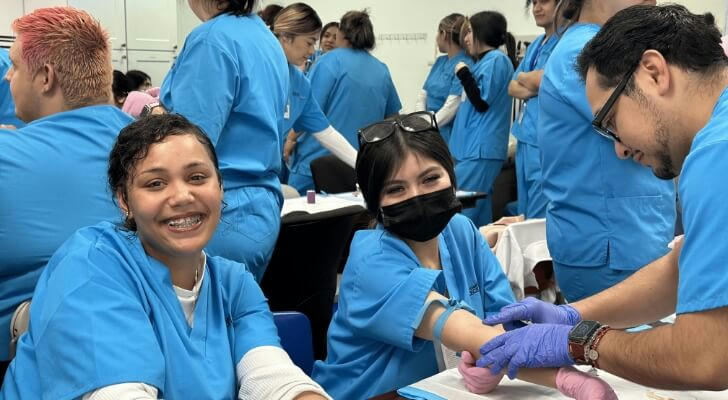A Comprehensive Guide to Medical Assistant Training Courses in the United States: Master Core Skills and Career Development Paths
In the U.S. healthcare system, medical assistants (MAs) play a key role in connecting patients, doctors, and medical institutions. According to the U.S. Bureau of Labor Statistics (BLS), the employment of medical assistants reached 826,000 in 2024, with a projected growth rate of 16% over the next ten years, which is much faster than the average for all occupations. This role combines clinical and administrative functions, and its flexible entry requirements attract many career changers. This article outlines the key training points through real-life examples and scientific methodology.

1. Classification of Medical Assistant Roles and Career Transition Paths
1.1 Clinical and Administrative Dual Functions
Clinical Functions: Measuring vital signs (blood pressure, heart rate), administering vaccinations, blood collection and specimen handling, assisting in the sterilization of small surgical instruments.
Administrative Functions: Managing patient appointments, processing insurance billing, entering electronic health records (EHR), monitoring medication inventory.
Industry Standard: About 63% of medical assistants are required to perform both clinical and administrative duties (source: AAMA 2023 report).
1.2 Typical Career Transition Case Studies
Case 1: Retail Worker Transitioning to Comprehensive Clinic MA
Maria Gomez from Sacramento, California, previously worked as a cashier at a chain supermarket earning $28,000 annually. She chose a community college certification program (900 hours, including 240 hours of clinical internship), focusing on EHR system operations and venipuncture techniques. Six months later, she obtained the Certified Medical Assistant (CMA) certification and is now employed at a family medical clinic, with her salary increasing to $41,000 along with health insurance and paid training benefits.
Recommendation:
Prioritize CCMA (Clinical Certified Medical Assistant) or CMA courses, as they cover a wider range of skills.
Actively participate in patient flow simulations during the internship to gain real-life scenario experience.
Case 2: Pediatric Specialty MA's Skill Enhancement Path
Jason Miller from Texas originally worked as a general clinic MA. He decided to specialize in pediatrics by completing the American Academy of Pediatrics' (AAP) Pediatric Advanced Life Support (PALS) certification and learning pediatric anxiety management techniques and developmental assessment standards. He now works in a pediatric specialty clinic in Dallas, earning 22% more per hour than a general MA, and participates in vaccine clinical trial management.
Recommendation:
Obtain specialized certifications (e.g., NHA Pediatric Medical Assistant certification).
Regularly attend evidence-based medicine webinars organized by the AMA (American Medical Association).

2. Core Modules of Training Courses and Learning Strategies
2.1 Rapid Mastery of Anatomy and Medical Terminology
Pain Point Case: A trainee in Michigan failed to master abbreviations like "Hypothyroidism" and "Hypertension," resulting in errors in patient record entries.
Solution:
Use spaced repetition tools (e.g., Anki) to categorize terms by body systems.
Participate in role-playing exercises simulating doctor-patient interactions to practice medical terminology.
2.2 Key Clinical Skills Training
Advanced Venipuncture Techniques:
A Florida training center uses a "double-blind practice" method, where trainees perform venipuncture with their vision blocked, relying on tactile feedback to locate veins. This method has an 91% success rate, compared to 76% with traditional methods.
Recommendation:
Choose institutions equipped with venipuncture arm models to observe liquid return pressure feedback.
Record daily data on needle angle and insertion speed to optimize muscle memory.

2.3 Administrative System Practical Focus
Efficient EHR Data Entry:
A medical group in New York uses keyboard shortcuts (e.g., Ctrl+Alt+V to jump to the vaccine record screen), which has led to a 19% increase in daily patient processing.
Recommendation:
Focus on Epic or Cerner system training (which cover over 67% of the U.S. healthcare market).
Create personalized templates, including chronic disease follow-up reminders.
3. Certification Exam Strategies and Common Pitfalls
3.1 Exam Data Analysis
The pass rate for the CMA (Certified Medical Assistant) exam is about 68%, with common areas of failure:
Not understanding the CLIA lab regulations and exemptions (23% failure rate).
Confusing HIPAA privacy regulations, particularly the "minimum necessary information" principle (18% failure rate).
3.2 Efficient Study Plan
Mistake Categorization Method:
A candidate in Arizona categorized their incorrect answers into three main areas: "drug dosage calculations," "legal regulations," and "skills procedures." After targeted revision, their score improved by 41%.
Resources Recommended:
Purchase the AAMA's official CMA Exam Blueprint, which outlines the 140 key knowledge areas.
Subscribe to the MedicalAssistantExamPrep online question bank (over 1,000 situational judgment questions).
3.3 Choosing the Right Institution
Risk Case: A non-accredited institution in Ohio promised a 98% pass rate but used outdated exam question banks, resulting in the disqualification of students' exam applications.
Review Points:
Ensure the course is accredited by CAAHEP or ABHES (the two main U.S. medical education accreditation bodies).
Verify faculty qualifications (must hold CMA or RN certifications with at least five years of clinical experience).
4. Career Advancement Paths and Resource Integration
4.1 Salary Growth Pathways
Specialty Certification Premium: Oncology MAs, who must master chemotherapy drug handling protocols, earn an average hourly wage of $24.50, compared to $19.70 for general MAs.
Management Role Transition: MAs who move into clinic management roles can earn between $58,000 and $72,000 annually (requiring additional training in health informatics).
4.2 Recommended Resources
Industry Organizations: Join AAMA to access free clinical guideline updates and job referral services.
Technical Tools: Use EHR simulators like SimChart to enhance system operation fluency.
Legal Updates: Subscribe to FDA medical device alerts to stay informed on new glucose meter operation standards.
Conclusion
The value of medical assistants continues to grow with the expansion of the U.S. primary care network. The key to success lies in choosing accredited, hands-on training programs and accumulating diverse real-world experience early in one's career (e.g., emergency triage, chronic disease management). It is recommended that professionals update their AMA Continuing Education Units (CEUs) every two years and pursue specialty certifications to enhance their indispensability. For career changers, a balanced focus on both administrative and clinical skills maximizes job opportunities.
